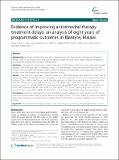Files in this item
Evidence of improving antiretroviral therapy treatment delays : an analysis of eight years of programmatic outcomes in Blantyre, Malawi
Item metadata
| dc.contributor.author | Sloan, Derek J. | |
| dc.contributor.author | Van Oosterhout, Joep J. | |
| dc.contributor.author | Malisita, Ken | |
| dc.contributor.author | Phiri, Eddie M. | |
| dc.contributor.author | Lalloo, David G. | |
| dc.contributor.author | O'Hare, Bernadette | |
| dc.contributor.author | MacPherson, Peter | |
| dc.date.accessioned | 2013-05-28T15:31:00Z | |
| dc.date.available | 2013-05-28T15:31:00Z | |
| dc.date.issued | 2013-05-21 | |
| dc.identifier | 53889312 | |
| dc.identifier | d656692b-9e5d-4cc9-9af5-8569eac53eb1 | |
| dc.identifier | 84877904981 | |
| dc.identifier | 84877904981 | |
| dc.identifier | 23687946 | |
| dc.identifier.citation | Sloan , D J , Van Oosterhout , J J , Malisita , K , Phiri , E M , Lalloo , D G , O'Hare , B & MacPherson , P 2013 , ' Evidence of improving antiretroviral therapy treatment delays : an analysis of eight years of programmatic outcomes in Blantyre, Malawi ' , BMC Public Health , vol. 13 , 490 . https://doi.org/10.1186/1471-2458-13-490 | en |
| dc.identifier.issn | 1471-2458 | |
| dc.identifier.other | ORCID: /0000-0003-1730-7941/work/27345673 | |
| dc.identifier.other | ORCID: /0000-0002-7888-5449/work/60631046 | |
| dc.identifier.uri | https://hdl.handle.net/10023/3562 | |
| dc.description.abstract | AbstractBackground: Impressive achievements have been made towards achieving universal coverage of antiretroviral therapy (ART) in sub-Saharan Africa. However, the effects of rapid ART scale-up on delays between HIV diagnosisand treatment initiation have not been well described.Methods: A retrospective cohort study covering eight years of ART initiators (2004–2011) was conducted at Queen Elizabeth Central Hospital (QECH) in Blantyre, Malawi. The time between most recent positive HIV test and ARTinitiation was calculated and temporal trends in delay to initiation were described. Factors associated with time to initiation were investigated using multivariate regression analysis.Results: From 2004–2011, there were 15,949 ART initiations at QECH (56% female; 8% children [0–10 years] and 5% adolescents [10–20 years]). Male initiators were likely to have more advanced HIV infection at initiation than female initiators (70% vs. 64% in WHO stage 3 or 4). Over the eight years studied, there were declines in treatment delay, with 2011 having the shortest delay at 36.5 days. On multivariate analysis CD4 count <50 cells/μl (adjusted geometric mean ratio [aGMR]: aGMR: 0.53, bias-corrected accelerated [BCA] 95% CI: 0.42-0.68) was associated with shorter ART treatment delay. Women (aGMR: 1.12, BCA 95% CI: 1.03-1.22) and patients diagnosed with HIV at another facility outside QECH (aGMR: 1.61, BCA 95% CI: 1.47-1.77) had significantly longer treatment delay.Conclusions: Continued improvements in treatment delays provide evidence that universal access to ART can be achieved using the public health approach adopted by Malawi However, the longer delays for women and patients diagnosed at outlying sites emphasises the need for targeted interventions to support equitable access for these groups. | |
| dc.format.extent | 7 | |
| dc.format.extent | 427083 | |
| dc.language.iso | eng | |
| dc.relation.ispartof | BMC Public Health | en |
| dc.subject | Africa | en |
| dc.subject | Antiretroviral therapy | en |
| dc.subject | HIV | en |
| dc.subject | HIV testing and counselling | en |
| dc.subject | Linkage to care | en |
| dc.subject | Programmatic research | en |
| dc.subject | QR355 Virology | en |
| dc.subject | RA Public aspects of medicine | en |
| dc.subject | Public Health, Environmental and Occupational Health | en |
| dc.subject | SDG 3 - Good Health and Well-being | en |
| dc.subject.lcc | QR355 | en |
| dc.subject.lcc | RA | en |
| dc.title | Evidence of improving antiretroviral therapy treatment delays : an analysis of eight years of programmatic outcomes in Blantyre, Malawi | en |
| dc.type | Journal article | en |
| dc.contributor.institution | University of St Andrews. School of Medicine | en |
| dc.contributor.institution | University of St Andrews. Global Health Implementation Group | en |
| dc.identifier.doi | https://doi.org/10.1186/1471-2458-13-490 | |
| dc.description.status | Peer reviewed | en |
| dc.identifier.url | http://www.biomedcentral.com/1471-2458/13/490 | en |
This item appears in the following Collection(s)
Items in the St Andrews Research Repository are protected by copyright, with all rights reserved, unless otherwise indicated.

